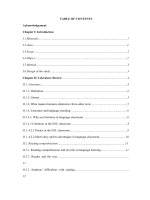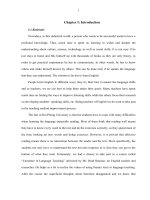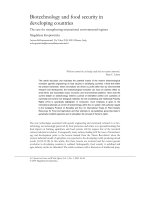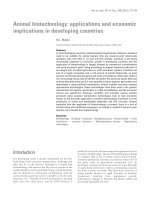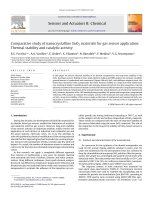Nano femtosecond laser processing in developing nanocrystalline functional materials for multi core orthogonal fluxgate sensor
Bạn đang xem bản rút gọn của tài liệu. Xem và tải ngay bản đầy đủ của tài liệu tại đây (2.99 MB, 142 trang )
NANO/FEMTOSECOND LASER PROCESSING IN
DEVELOPING NANOCRYSTALLINE FUNCTIONAL
MATERIALS FOR MULTI-CORE ORTHOGONAL
FLUXGATE SENSOR
TAN LI SIRH
(B.Eng. (Hons.),NUS)
A THESIS SUBMITTED
FOR THE DEGREE OF MASTER OF ENGINEERING
NANOSCIENCE & NANOTECHNOLOGY INITIATIVE
NATIONAL UNIVERSITY OF SINGAPORE
2009
Acknowledgements
ACKNOWLEDGEMENTS
I would like to express my utmost sincere and greatest appreciation to my
supervisors, Professor Li Xiaoping and Associate Professor Hong Minghui, for their
guidance throughout my Master project. Their valuable opinions have been utmost
importance to me.
I am also grateful to Dr. Seet Hang Li for all his advices and help throughout my
project. In addition, I would like to thank all members in Neurosensors Lab and Laser
Microprocessing Lab for sharing their research experience and helping me in one way
or another. I would also like to express my heartfelt gratitude to Miss Jasmin Lee
from NUSNNI programme, Mr Lim Boon Chow from A-STAR Data Storage Institute
(DSI), Miss Li Xue from A-STAR Institute of Materials and Research Engineering
(IMRE) and staff at the Advanced Manufacturing Lab (AML) and Materials Science
Lab (MSL) for all their kind assistance.
Lastly, I wish to thank all those who have supported, helped and accompanied me
throughout my two years of the Masters course.
i
Table of Contents
TABLE OF CONTENTS
ACKNOWLEDGEMENTS ................................................................................................. i
TABLE OF CONTENTS.................................................................................................... ii
SUMMARY ........................................................................................................................ v
LIST OF TABLES ........................................................................................................... viii
LIST OF FIGURES ........................................................................................................... ix
LIST OF SYMBOLS ........................................................................................................ xv
LIST OF PUBLICATIONS ............................................................................................. xvi
Chapter 1 Introduction ........................................................................................................ 1
1.1 Motivation ..................................................................................................................... 1
1.2 Objectives of Present Study .......................................................................................... 5
1.3 Organization of Thesis .................................................................................................. 6
Chapter 2 Literature Review ............................................................................................... 7
2.1 Magnetic Materials and Relevant Theories .................................................................. 7
2.1.1 Basic Classification of Magnetic Materials ......................................................... 7
2.1.2 Ferromagnetic Materials and Their Properties .................................................... 9
2.1.3 Curie Temperature Tc .......................................................................................... 9
2.1.4 Hysteresis ............................................................................................................. 9
2.1.5 Factors Affecting Magnetic Quality .................................................................. 10
2.1.6 Domain Wall Theories ....................................................................................... 11
2.1.7 Magnetization Rotation ...................................................................................... 11
2.1.7.1 Crystalline Anisotropy ............................................................................12
2.1.7.2 Stress Anisotropy ....................................................................................12
2.1.7.3 Shape Anisotropy ....................................................................................12
2.2 Types of Lasers ........................................................................................................... 13
2.2.1 Nanosecond Laser .............................................................................................. 13
2.2.2 Femtosecond Laser ............................................................................................ 14
2.2.3 Effects of Nanosecond and Femtosecond Lasers on Magnetic Materials ......... 18
2.3 Fabrication Methods ................................................................................................... 21
2.3.1 Template Fabrication ......................................................................................... 21
2.3.1.1 Conventional Methods ............................................................................21
2.3.1.2 Laser Micromachining Method...............................................................23
2.3.2 Magnetic Material Deposition Methods .............................................................24
2.3.2.1 Electrodeposition ....................................................................................24
2.3.2.2 Electron-beam evaporation .....................................................................25
Chapter 3 Research Approach and Experimental Setup ................................................... 28
3.1 Research Approach ..................................................................................................... 28
3.2 Materials Development and Fabrication Processes .................................................... 28
3.2.1 Laser Systems .................................................................................................... 28
3.2.1.1 355nm Nd:YAG nanosecond laser .........................................................28
3.2.1.2 800nm Ti:Sapphire femtosecond laser....................................................29
3.2.2 Deposition Set-up............................................................................................... 30
3.2.2.1 Electron-beam Evaporation ....................................................................30
3.2.2.2 Electrodeposition ....................................................................................31
ii
Table of Contents
3.3 Materials Properties Characterization Setup ............................................................... 34
3.3.1 Profilometer ....................................................................................................... 34
3.3.2 Optical Microscope ............................................................................................ 34
3.3.3 Scanning Electron Microscopy (SEM) and Field Emission Scanning
Electron Microscopy (FESEM) ......................................................................... 35
3.3.4 Energy Dispersive X-ray (EDX)........................................................................ 36
3.3.5 X-Ray Diffraction (XRD) .................................................................................. 37
3.3.6 Vibrating Specimen Magnetometer (VSM) Setup ............................................. 39
Chapter 4 Nanosecond Pulsed Laser-assisted Micro-drilling of Templates and
Electroplating Deposition of Nanocrystalline Permalloy ................................................. 40
4.1 Research Approach ..................................................................................................... 40
4.2 Template Fabrication .................................................................................................. 41
4.2.1 Selection of Machined-drilled or Laser-drilled Templates ................................ 41
4.2.2 Methods of Adhesion ......................................................................................... 43
4.2.3 Fabrication of Single and Stacked Templates .................................................... 44
4.3 Laser Parameters ......................................................................................................... 45
4.3.1 Laser Fluence Effect .......................................................................................... 46
4.3.2 Laser Irradiation Time Effect............................................................................. 48
4.3.3 Pulse Number Effect .......................................................................................... 50
4.3.4 Laser Focal Length Effect .................................................................................. 51
4.3.5 Optimization of Laser Parameters ..................................................................... 54
4.4 Study of Electrodeposition Parameters ....................................................................... 55
4.4.1 XRD Analysis .................................................................................................... 55
4.4.2 Plating Current Efficiency ................................................................................. 57
4.4.3 Plating Current Density...................................................................................... 58
4.4.3.1 Composition (Ni%) .................................................................................58
4.4.3.2 Diameter of Electroplated Wires ............................................................60
4.4.3.3 Number of Electroplated Wires ..............................................................62
4.4.4 Plating Time ....................................................................................................... 64
4.4.4.1 Composition ............................................................................................64
4.4.4.2 Material Structure ...................................................................................67
4.4.5 Template Electrodeposition ............................................................................... 68
4.5 Electrodeposited Structures ........................................................................................ 70
4.5.1 Single Template ................................................................................................. 70
4.5.2 Stacked Templates ............................................................................................. 74
4.5.3 Single Template with Varying Array Size ......................................................... 75
Chapter 5 Femtosecond Laser Machining of Magnetic Materials .................................... 79
5.1 Research Approach ..................................................................................................... 79
5.2 Commercial Vitrovac 6025X ...................................................................................... 80
5.2.1 Material Removal Rate ...................................................................................... 81
5.2.2 Morphology of Laser-Machined Channels ........................................................ 82
5.2.3 Study of Laser Fluence Effect on Composition at Ablated and Damaged
Areas .................................................................................................................. 83
5.2.4 XRD Analysis .................................................................................................... 85
5.2.5 Study of Laser Fluence on Magnetic Properties ................................................ 86
5.2.5.1 Hysteresis ................................................................................................86
5.2.5.2 Coercivity ................................................................................................87
5.2.6 Influence of Different Numbers of Ablated Channels on Magnetic Properties. 89
iii
Table of Contents
5.2.6.1 Hysteresis ................................................................................................89
5.2.6.2 Coercivity ................................................................................................90
5.3 Electron-beam Deposited Permalloy .......................................................................... 91
5.3.1 Surface Morphology of Laser-Machined Channels ........................................... 91
5.3.1.1 Laser Fluence Effect ...............................................................................91
5.3.1.2 Number of Pulses ....................................................................................95
5.3.2 Study of Laser Fluence Effect on Composition at Ablated and Damaged
Areas .................................................................................................................. 97
5.3.3 XRD Analysis .................................................................................................... 99
5.3.4 Laser Fluence Effect ........................................................................................ 102
5.3.4.1 Hysteresis ..............................................................................................102
5.3.4.2Coercivity ...............................................................................................103
Chapter 6 Conclusions and Recommendations............................................................... 108
6.1 Conclusions ............................................................................................................... 108
6.2 Future Works ............................................................................................................ 113
6.2.1 Methods to improve laser-drilling of templates and electroplating of
nanocrystalline Permalloy ................................................................................ 113
6.2.2 Method to improve femtosecond laser machining on magnetic materials ...... 115
Reference ........................................................................................................................ 117
iv
Summary
SUMMARY
In the development of magnetic sensing elements, the sensitivity of magnetic sensors
have been found to increase exponentially when multi-core structures are used as
sensing elements. These multi-core structures can be achieved by template assisted
deposition/electrodeposition or direct processing. In this project, multi-core structured
functional magnetic materials of extremely high permeability have been successfully
developed with the assistance of either nanosecond or femtosecond lasers. Methods
such as nanosecond laser drilling of polymeric templates for electrodeposition of
nanocrystalline nickel-iron wires and femtosecond laser machining of Vitrovac
6025X and nickel-iron thin films are investigated. Both methods are found to be
suitable to obtain multi-core structures.
Nanosecond laser-drilled templates selected as smaller hole diameter can be achieved
using this approach. This would yield high aspect ratio holes for electroplating. In
addition, there is higher wire density per template, with the template dimensions held
constant. Laser processing parameters such as laser fluence, laser irradiation time and
number of pulses were studied. The diameter of the laser-drilled hole and the ablation
depth are found to be dependent on the laser fluence. An increase in the applied laser
fluence will increase both parameters. Higher laser irradiation time amplifies the heat
affected zones and a threshold number of pulses are required to obtain a clean welldrilled hole. Laser-drilled holes are also known to have tapered profile. In order to
minimize tapering, the focal point is set at the top surface of the template. With the
achieved templates, electrodeposition was then carried out to fill the drilled holes with
Ni-Fe. Using XRD, the electroplated Ni-Fe is found to be of FCC structure, with the
v
Summary
lattice constant calculated to be 0.354 nm and having an average crystallite/grain size
of 34.5 nm. In order to gain an understanding and control of the electrodeposition
process, the effect of varying plating current density and plating time on the resulting
composition was investigated. Experiments were also conducted to investigate the
value of the plating current density in order to achieve Permalloy composition for
templates with different hole diameters and array sizes (wire number). The results
show that the materials composition is independent of both the hole diameters and the
array sizes. Since 1 mm thick polymeric templates are used, vacuum (for partial
removal of air bubbles) and ultrasonic agitation during electroplating are introduced
to minimize “blockage” of the laser drilled holes. This has been found to be effective
in achieving high aspect ratio (1:25) wires. If the laser-drilled templates are stacked,
the best aspect ratio achieved for deposited nanocrystalline Ni-Fe wires has been
found to be 1:50 (pillars of ~ 40 m diameter and 2mm in length), with a composition
of 83% nickel and 17% iron. When multiple holes of different array sizes on the same
template are placed in the electrolyte, composition of nickel-iron varies due to the
ions distribution in the cell varied along the electrolyte.
Femtosecond laser (direct) processing of magnetic materials were successfully carried
out on Vitrovac 6025X foils and electron-beam evaporated Ni-Fe thin films. The
results showed that femtosecond laser processing is a feasible way to fabricate multicore sensing elements. For multi-core Vitrovac 6025X, no composition distribution of
the ablated magnetic foils were observed across the entire surface profile, suggesting
no diffusion process took place during ablation. Hysteresis loops, obtained from
samples ablated using different laser fluences as well as specimens with different
numbers of ablated channels, show that the overall anisotropy of the magnetic foils
vi
Summary
before and after femtosecond laser processing did not change significantly and that
the magnetic property of the specimens (i.e. coercivity) did not deteriorate
significantly, even when a significant amount of the magnetic materials was ablated.
For multi-core Ni-Fe thin films, it is observed that there is a 5% increment in terms of
coercivity for fully ablated channels. However, the results show that femtosecond
laser irradiation can be manipulated to modify the properties of Ni-Fe. Surface
modification was observed. Ripples formation, tilted to an angle to the direction of the
beam, was observed when different laser fluences were applied to the nanocrystalline
films. When the polarization state of the laser beam was changed to 90°, shorter
ripples (parallel to beam’s scanning direction) were formed. As the number of
ablative pulses increased, formation and collapse of ripples occurred earlier than that
of the threshold laser fluence at single pulse. XRD analysis suggests that rapidquenching effect changes the surface layer from nanocrystalline to amorphous and
that the average crystallite/grain size decreases upon ripples formation. After laser
ablation, regardless of the value of the laser fluences, anisotropy has shifted towards
the easy axes of the films. The appearance of ripples marks the point when coercivity
of the magnetic material begins to decrease. It appears that there is a laser fluence
threshold for both average crystallite/grain size and coercivity to decrease to a
minimum, beyond which coercivity will increase at a gradual rate.
vii
List of Tables
LIST OF TABLES
Table 2.1: Summary of classification of magnetic properties ....................................... 7
Table 2.2: Types of anisotropy .................................................................................... 12
Table 3.1: List of fabrication equipment used in this project ...................................... 28
Table 3.2: List of characterization equipment used in this project .............................. 28
Table 3.3: Electrolyte solution content ........................................................................ 32
Table 4.1: Calculations from XRD results ................................................................... 56
Table 4.2: Summary of grain size results..................................................................... 57
Table 4.3: Summary of current efficiency results ........................................................ 58
Table 4.4: Summary of hole diameter, plating area, plating current in relation to a
constant current density ............................................................................................... 62
Table 5.1: Composition of Ni-Fe (%) after laser ablation at non-ablated and ablated
areas. ............................................................................................................................ 99
Table 5.2: Calculations from XRD results. ................................................................ 100
viii
List of Figures
LIST OF FIGURES
Figure 2.1: A typical hysteresis curve.......................................................................... 10
Figure 2.2: Process of magnetization ........................................................................... 11
Figure 2.3: Nanosecond laser processing..................................................................... 13
Figure 2.4: SEM image of an ablated metal channel created by a nanosecond laser. . 14
Figure 2.5: SEM image showing minimum amount of re-deposited material after
femtosecond laser ablation........................................................................................... 15
Figure 2.6: Nanosecond laser processing..................................................................... 16
Figure 2.7: Easy axis M-H loops (a) before and (b) after fabrication of grooves
parallel to the as-deposited hard axis in FeN monolayer ............................................. 19
Figure 2.8: Hysteresis loops of Finemet: (a) sample non-treated by laser, (b) laser
treated sample with small density dotted lines, and (c) laser treated sample with high
density of dotted lines .................................................................................................. 20
Figure 2.9: XRD analysis of amorphous alloy ribbon before and after laser
micromachining ........................................................................................................... 20
Figure 2.10: Photograph showing patterned template on developed negative
photoresist layer. .......................................................................................................... 21
Figure 2.11: FESEM image of developed bi-layered photoresist after single exposure.
...................................................................................................................................... 22
Figure 3.1: Schematics of the laser drilling setup. ....................................................... 29
Figure 3.2: Schematic representation of the laser set-up for cutting magnetic foils.... 30
Figure 3.3: Schematics of the electrodeposition setup................................................. 31
Figure 3.4: Diamond tip-wafer surface interaction ...................................................... 34
Figure 3.5: Set of atomic planes in a crystal, at an angle θ from the incident beam ... 38
ix
List of Figures
Figure 4.1: Workflow for nanosecond laser-drilled templates for electrodeposition of
nanocrystalline Ni-Fe. .................................................................................................. 41
Figure 4.2: SEM photos showing (a) circular hole profile by machining; and (b) noncircular hole profile by laser drilling. .......................................................................... 42
Figure 4.3: SEM images of (a) tapered indentations on the Cu substrate by mechanical
machining; (b) flat indentations on the Cu substrate by low fluence laser drilling; (c)
round/concave indentations on the Cu substrate by high fluence laser drilling;
Schematics showing (d) deposited hollow micro wires from mechanical machined
templates; (e) solid micro wires resulting from the formation of flat indentations from
low fluence laser drilling; (f) hollow micro wires resulting from the formation of
round/concave indentations. ........................................................................................ 43
Figure 4.4: PVC template piece was glued onto copper substrate before laser drilling.
As a result, the copper surface is also ablated. ............................................................ 44
Figure 4.5: Array is drilled into PVC before adhesion onto copper substrate. The
copper substrate is unaffected by the laser. ................................................................. 44
Figure 4.6: The characteristic of this method is to drill an array of holes onto thin
pieces of template material, and subsequently stacking and aligning them to form a
resultant array of high aspect ratio. .............................................................................. 45
Figure 4.7: Relationship of laser fluence versus entry hole diameter at a pulse
repetition rate of 1 kHz, laser irradiation time of 500 ms and the number of loop of 1.
...................................................................................................................................... 47
Figure 4.8: Dependence of diameter of heat affected zone on laser irradiation time at
a laser fluence of 19.1J/cm2, pulse repetition rate of 1 kHz, and number of loop of 1.
The inset image shows a top view of a laser drilled hole on PVC surface. ................. 49
Figure 4.9: Schematics showing the effects of laser irradiation time with the HAZ
size. .............................................................................................................................. 50
Figure 4.10: Hole diameter versus number of pulses at a laser fluence of 19 J/cm2,
pulse repetition rate of 1kHz, and laser irradiation of 500 ms. .................................... 51
Figure 4.11: Surface profile of a laser drilled hole with profile. ................................. 52
x
List of Figures
Figure 4.12: Tapering ratio versus distance from surface of template ( m)................ 53
Figure 4.13: Tapering angle (˚) versus distance from surface of template ( m). ........ 54
Figure 4.14: (a) Front view of optimized laser micro-drilled 10×10 array; (b) back
view of the array, showing that the holes were fully penetrated, and the small
differences between front and back hole diameters (difference < 5 m)..................... 55
Figure 4.15: Graph of counts per second against 2 angle .......................................... 56
Figure 4.16: Graph of number of micro wires (with that particular iron content)
against iron content (%) for the current density of 35 A/dm2. ..................................... 59
Figure 4.17: Graph of number of micro wires (with that particular iron content)
against iron content (%) for the current density of 45 A/dm2. ..................................... 59
Figure 4.18: Graph of hole diameter (in µm) against composition (in %) for a current
density of 45 A/dm2 and a plating time of 3 hours. ..................................................... 61
Figure 4.19: Graph of nickel content (%) against number of micro wires for a hole
diameter of 200 µm using a current density of 45 A/dm2 with a plating time of 3
hours............................................................................................................................. 63
Figure 4.20: Graph of nickel content (%) against number of micro wires for a hole
diameter of 300 µm using a current density of 45 A/dm2 with a plating time of 3
hours............................................................................................................................. 63
Figure 4.21: Graph of number of micro wires (with that particular nickel content)
against nickel content (%) for a plating period of 3 hours at a current density of 45
A/dm2. .......................................................................................................................... 64
Figure 4.22: Graph of number of micro wires (with that particular nickel content)
against nickel content (%) for a plating period of 6 hours at a current density of 45
A/dm2. .......................................................................................................................... 65
Figure 4.23: Graph of number of micro wires (with that particular nickel content)
against nickel content (%) for a plating period of 9 hours at a current density of 45
A/dm2. .......................................................................................................................... 65
Figure 4.24: Graph of average nickel content (%) against plating time (in hours) for a
current density of 45 A/dm2. ........................................................................................ 66
xi
List of Figures
Figure 4.25: Variation of deposited structures and deposition rate with plating time of
(a) 3, (b) 6 hours and (c) 9 hours. ................................................................................ 67
Figure 4.26: Trapped air in template holes preventing electrolyte from reaching
substrate and electrodeposition cannot take place. ...................................................... 68
Figure 4.27: Photograph of template showing excess Ni-Fe on the template edges, as
well as deposited Ni-Fe emerging from the template holes. ........................................ 71
Figure 4.28: SEM picture showing the overgrowth layers of deposited Ni-Fe. .......... 71
Figure 4.29: (a) SEM picture showing the overview of the whole array. The number
of holes filled with Ni-Fe deposits come up to be 87 out of 100. (b) SEM picture
showing a close-up view of the array. ......................................................................... 72
Figure 4.30: SEM pictures showing (a) top view; (b) 3-D view: of ablated copper
surface after the covering PVC layer is removed. During laser microdrilling the PVC
was pasted onto the copper using epoxy adhesive and was removed thereafter so that
the surface of the copper can be examined. ................................................................. 73
Figure 4.31: Close up pictures of some of the deposited Ni-Fe pillars at (a) spot A;
and (b) spot B; which have gaps or holes in them, which leads to the investigation of
whether the pillars are hollow. ..................................................................................... 73
Figure 4.32: Schematics of template on copper substrate. The template was laser
drilled before being pasted onto the copper. ................................................................ 74
Figure 4.33: SEM images showing (a) top view; and (b) close-up 3-D view; of top
surface of the array after filing..................................................................................... 75
Figure 4.34: Schematics of the arrangement of arrays on the template. ...................... 75
Figure 4.35: SEM images of the various arrays after filing: (a) 4×4 array; (b) 6×6
array; (c) 8×8 array; (d) 10×10 array. .......................................................................... 76
Figure 4.36: The template arrays and their compositions. ........................................... 77
Figure 5.1: Workflow for femtosecond laser machining of magnetic materials. ........ 79
Figure 5.2: Schematic diagrams showing dimensions of Vitrovac 6025X specimens
with (a) 1 channel ablated and (b) 7 channels ablated. ................................................ 80
xii
List of Figures
Figure 5.3: Influence of laser fluence on number of loop in order to ensure the
ablation of a fully penetrated channel on the magnetic specimens with pulse repetition
rate of 1 kHz and stage speed of 100 mm/min............................................................. 81
Figure 5.4: SEM images of the channels fabricated at different laser fluences of (a) 13
J/cm2 and (b) 38 J/cm2. ................................................................................................ 83
Figure 5.5: Charts showing the composition of Vitrovac 6025X at various locations
when ablated by 3 J/cm2. ............................................................................................. 84
Figure 5.6: Charts showing the composition of Vitrovac 6025X at various locations
when ablated by 38 J/cm2. ........................................................................................... 85
Figure 5.7: XRD results showing the intensity peaks of Vitrovac 6025X without laser
ablation and at different laser fluences. ....................................................................... 86
Figure 5.8: Hysteresis loops obtained for applying an external field: (a) parallel; and
(b) perpendicular to the magnetic foil fabricated at different laser fluences. .............. 87
Figure 5.9: Coercivities obtained for applying an external field: (a) parallel; and (b)
perpendicular to the magnetic foil fabricated at different laser fluences. .................... 88
Figure 5.10: Hysteresis loops obtained for applying an external field: (a) parallel; and
(b) perpendicular to magnetic foil with 1-7 laser fabricated channels......................... 89
Figure 5.11: Coercivities obtained for applying an external field: (a) parallel; and (b)
perpendicular to magnetic foil with 1-7 laser fabricated channels. ............................. 90
Figure 5.12: FESEM images showing the effects of femtosecond laser irradiation on
Permalloy at different laser fluences a) 14 mJ/cm2, b) 27 mJ/cm2, c) 34 mJ/cm2 and d)
51 mJ/cm2. The arrow indicates the scanning direction of the laser beam. ................. 93
Figure 5.13: FESEM images showing the effects of femtosecond laser irradiation on
Permalloy different laser fluences a) 14 mJ/cm2, b) 27 mJ/cm2, c) 34 mJ/cm2 and d) 51
mJ/cm2 for 90° polarization. The arrow indicates the scanning direction of the laser
beam. ............................................................................................................................ 94
Figure 5.14: FESEM images showing the effects of applying a) 2, b) 3, c) 4 and d) 5
laser pulses on Permalloy at laser fluence 14 mJ/cm2. ................................................ 96
xiii
List of Figures
Figure 5.15: FESEM images showing the effects of applying a) 2, b) 3, c) 4 and d) 5
laser pulses on Permalloy at laser fluence 27 mJ/cm2. ................................................ 97
Figure 5.16: Chart showing the average percentage of nickel and iron content for 8
different specimens before laser ablation. ................................................................... 98
Figure 5.17: XRD results showing the intensity peaks of Permalloy at different laser
fluences. ..................................................................................................................... 100
Figure 5.18: Graph shows the variation in average crystallite/grain size due to
different laser fluences. .............................................................................................. 101
Figure 5.19: Hysteresis loops measured along the magnetic field after laser ablation.
.................................................................................................................................... 103
Figure 5.20: Percentage difference coercivity before and after laser ablation. ......... 104
Figure 6.1: SEM images of the drilled holes and their replicas ................................. 113
Figure 6.2: Exit of a hole produced in 1 mm thick steel plate using diffractive optical
element without any change in the polarization state ................................................ 114
Figure 6.3: Exit of a hole produced in 1 mm thick steel plate using diffractive optical
element and polarization trepanning technique ......................................................... 114
xiv
List of Symbols
LIST OF SYMBOLS
Z
H
Hmax
TC
µ
µo
µr
Ce
Ci
γ
ρ
U
Pe
Pi
Pc
Q(x)
Te
ke
S
I(t)
α
A
Pth
co
Fth
δ
λ
P
θ
D
B
T
E
Ar
R
D
D
A
Lex
Ae
K1
Ke
N
Dg
Impedance
Applied field
External magnetic field
Curie temperature
Permeability
Permeability of free space
Relative permeability
Heat capacity of the electron subsystem
Heat capacity of the lattice subsystem
Electron-lattice coupling
Density
Velocity
Thermal electron pressure
Ion pressure
Elastic ( or ‘cold’) pressure
Heat flux
Temperature
Electron thermal conductivity
Laser heating source term
Laser intensity
Material absorption coefficient
Surface absorptivity
Threshold electron pressure
Speed of sound
Threshold laser fluence
Absorption length
Wavelength
Standing wave period
Angle
Pulse duration
Interplanar spacing
Broadening of diffraction line
Diameter or thickness
Laser pulse energy
Focal spot area
Ratio
Entrance diameter
Exit diameter
Lattice constant
Ferromagnetic exchange interaction length
Exchange stiffness
Magneto-crystalline anisotropy constant
Effective anisotropy
Number of grains
Grain size
xv
List of Publications
LIST OF PUBLICATIONS
Journal paper:
1. L.S. Tan, H.L. Seet, M.H. Hong and X.P. Li, “Effects of femtosecond laser
ablation on Vitrovac 6025X”, Journal of Materials Processing (In Press)
2. H.L. Seet, L.S. Tan, M.H. Hong, K.S.Lee, H.H. Teo, C.H. Lui and X.P. Li,
“Laser-drilled PVC template for electrodeposition of multi-core orthogonal
fluxgate sensing element”, Journal of Materials Processing (In Press)
3. L. Jiang, L.S. Tan, J.Z. Ruan, W.Z. Yuan, X.P. Li and Z.J. Zhao, “Intermittent
deposition and interface formation on the microstructure and magnetic
properties of NiFe/Cu composite wires”, Physica B 403 (2008) 3054-3058.
Conference paper:
1. L.S. Tan, H.L. Seet, M.H. Hong and X.P. Li, “Effects of femtosecond laser
ablation on Vitrovac 6025X”, 8th Asia-Pacific Conference on Materials
Processing, 15th – 20th June 2008, Guilin & Guangzhou, China
2. H.L. Seet, L.S. Tan, M.H. Hong, K.S. Lee, H.H. Teo, C.H. Lui and X.P. Li,
“Laser-drilled PVC template for electrodeposition of multi-core orthogonal
fluxgate sensing element”, 8th Asia-Pacific Conference on Materials
Processing, 15th – 20th June 2008, Guilin & Guangzhou, China
xvi
Chapter 1 Introduction
Chapter 1 Introduction
1.1 Motivation
Magnetic sensors are widely used in areas such as high-density magnetic recording,
navigation, military and security, target detection and tracking, anti-theft systems,
non-destructive testing, magnetic marking and labeling, geomagnetic measurements,
space research, measurements of magnetic fields onboard spacecraft and biomagnetic
measurements in the body [1]. The types of magnetic sensors available in the market
include induction sensors, fluxgate sensors, Hall Effect magnetic sensors, magnetooptical sensors, giant magnetoresistive (GMR) sensors, resonance magnetometers,
and superconducting quantum interference device (SQUID) gradiometers.
Currently, the market demand is shifting towards cheaper, smaller size and lower
power consumption alternatives without any comprise on the performance level in
terms of sensitivity. However, there is a trade-off between sensitivity, size, power and
cost. By making a comparison between existing magnetic sensors in terms of the
processing cost and power consumption, GMR sensor shows the lowest cost and
power consumption [1]. However, the field sensitivity of the GMR sensor is rather
low (~1%/Oe). A recent discovery based on giant magnetoimpedance (GMI) has lead
to an improvement for high performance magnetic sensors. The field sensitivity of a
typical GMI sensor can reach a value as high as 500%/Oe [1].
GMI effects occur when a soft ferromagnetic conductor is subjected to a small
alternating current (ac) in the presence of a direct current (dc) field and a large change
1
Chapter 1 Introduction
in the ac complex impedance of the conductor is achieved [1]. The relative change of
the impedance (Z) with applied field (H), which is defined as the GMI effect, is
expressed by
ΔZ / Z (%) = 100% ×
Z ( H ) − Z ( H max )
Z ( H max )
(1.1)
where Hmax is the external magnetic field sufficient to saturate the impedance.
It has been demonstrated by Chirac et al. [2] on glass-coated microwires array that
magnetoimpedance (MI) response of the array is dependent on the number of active
microwires and the current frequency. The results show that the highest magnetoimpedance response was found close to 6MHz for one microwire, 3MHz for two
connected microwires, 2MHz for three, four and five connected microwires, and
1MHz for the next microwires, when using a current of 10 mA. Recent research has
also shown that a multi-core sensing element increases the sensitivity of orthogonal
fluxgate sensor as a function of the number of ferromagnetic cores [3]. Measured
sensitivity increased exponentially with the number of ferromagnetic core wires
increased, where the “linear” curve was calculated by multiplying the number and the
sensitivity of a single-core sensor [3].
In order to enhance the performance of such magnetic sensors, one available option is
through improved processing and manufacturing [4]. For magnetic sensors used to
detect weak magnetic fields, a highly sensitive sensing element, with high
permeability, is needed. Therefore, the focus on this project is towards improving the
sensitivity of the magnetic sensors through its fabrication processes. In this project,
two methods are adopted to obtain regularly packed multi-core structures.
2
Chapter 1 Introduction
The first method makes use of nanosecond 355nm Nd:YAG laser to produce
polymeric template for electroplating nickel-iron (Ni-Fe) ferromagnetic cores.
Currently, wires array can be achieved through template electrodeposition and the
templates used in the process are usually anodic aluminum oxide (AAO) [5], PMMA
and co-polymer templates developed by e-beam lithography [6]. However, the holes
arrangement for these templates is random. Alternative approach is to laser-drill the
templates. Advantages of using laser-drilled templates include fast patterning,
repeatability and the desired template design can be programmed by software such as
Mastercam. In this research work, studies are made on the selection of machinedrilled or laser-drilled templates, methods of adhesion and fabrication of single and
stacked templates. Different laser processing parameters such as laser fluence, laser
irradiation time, number of pulses and laser focal length are investigated to optimize
laser drilling process on polymeric template.
Soft magnetic material (nickel-iron alloy) is chosen as the study material due to its
high initial permeability as well as near-zero magnetostriction. These quantities are
particularly significant in nickel-iron alloys between 75 and 80% nickel content [7].
Therefore, Permalloy with the composition percentage ratio of 81:19 NiFe was
selected as the ferromagnetic material. Research has shown that to obtain the selected
composition for the electroplated wires, the general approach is to increase the
deposition rate of iron in three different methods: 1) the current density can be
decreased; 2) the plating duration can be decreased and; 3) the amount of iron (II)
sulfate heptahydrate (FeSO4.7H2O) in the plating solution can be increased [8, 9].
Hence, template electrodeposition of nanocrystalline Ni-Fe is adopted as a mean of
achieving arrays of magnetic wires which would function as multi-core sensing
3
Chapter 1 Introduction
elements for weak magnetic fields. Templates with different array and hole sizes are
fabricated using laser drilling techniques. Thereafter, direct current electrodeposition
was carried out under controlled environment to deposit nanocrystalline Ni-Fe. The
magnitude of the plating current and plating time were varied to gain further
understanding of the electrochemistry involved. Characterization of the obtained
structures is carried out in terms of materials properties.
The second method involves femtosecond 800nm Ti:Sapphire laser machining on
commercial Vitrovac 6025X ribbons and electron-beam evaporated (Ni-Fe) thin films
in ambient conditions to produce regular arrays of long magnetic stripes. Unlike
nanosecond laser machining, processing of magnetic materials using femtosecond
laser does not create any domain pinning effects [10]. In addition, A. Semerok et. al.
has shown that femtosecond laser has higher ablation efficiency than nanosecond and
picosecond laser. The reason being for a femtosecond regime, a laser pulse terminates
before the energy is completely redistributed in the solid matter. It is likely that the
energy is deposited in the matter without laser plasma interaction resulting in better
ablation efficiency than the one in the picosecond and nanosecond regimes [11].
Hence, these justify the use of femtosecond laser as a suitable candidate to fabricate
magnetic sensor. Thin film and ribbons are chosen due to the even surface they have
as compared to the curved profile of wires. This allows laser processing to be carried
out with minimum interference from scattered reflected rays.
Electron-beam evaporation is adopted as sputtering process is not available.
Literatures have shown that this method is not recommended for deposition of alloy
material, as the composition is dependent on the vapour pressure of the elements.
4
Chapter 1 Introduction
However, the vapor pressure of nickel and iron are quite close to each other. The
vapor pressure of nickel and iron are 1 Pa at 1783K [12] and 1 Pa at 1728 K [13]
respectively. Hence, electron-beam evaporation method is used. Amorphous (noncrystalline) ferromagnetic alloy such as Vitrovac 6025X was also obtained from
Sekels, Germany. The amorphous state is achieved by rapid quenching of a liquid
alloy. In order to be termed as amorphous, the material must consist of about 80%
transition metal (usually Fe, Co, or Ni). Metalloid component (B, C, Si, P, or Al) is
also required to lower the melting point. Advantages of amorphous materials are that
their properties are nearly isotropic (not aligned along a crystal axis); this results in
low coercivity, low hysteresis loss, high permeability, and high electrical resistivity.
[14]
Large GMI effect exists in magnetic materials having low resistivity, high magnetic
permeability, high saturation magnetization and small ferromagnetic relaxation
parameter [1]. Though crystalline ferromagnetic materials such as Ni-Fe have lower
resistivity, but amorphous ones have better soft magnetic behavior in terms of higher
magnetic
permeability
and
saturation
magnetization
because
they
lack
magnetocrystalline anisotropy. For both magnetic materials, the influence of different
laser parameters on the magnetic materials will be investigated and the results are
characterized in terms of both material and magnetic properties.
1.2 Objectives of Present Study
The project primary objective is to develop multi-core structured functional magnetic
materials of extremely high permeability, using either nanosecond or femtosecond
lasers. The scope of the project includes:
5
Chapter 1 Introduction
1) Utilizing nanosecond laser and optimizing laser processing parameters in
approaches to achieve the desired structures, in particular, optimizing laser
process parameters for laser assisted micro-drilling of templates used in
electrodeposition to achieve Ni-Fe pillars arrays.
2) Carrying out studies and optimization of femtosecond laser processing
parameters on magnetic materials such as Vitrovac 6025X foils and Ni-Fe thin
films.
3) Characterizing the materials and magnetic properties of the achieved
structures, in particular verifying the extent of laser processing on the resulting
properties
4) Evaluating the feasibility of using laser processing approaches on magnetic
materials fabrication.
1.3 Organization of Thesis
This thesis is divided into 6 chapters. Chapter 1 gives an overall view of the
introduction, motivation, project objectives and organization of the thesis. Chapter 2
consists of the literature reviews done on magnetic materials and their relevant
theories and the effects of nanosecond and femtosecond lasers processing on magnetic
materials. Fabrication methods used to obtain multi-core structures were also
discussed. Chapter 3 covers the experimental setups and characterization equipment
used. Chapter 4 deals with the use of nanosecond (Nd:YAG) laser-assisted microdrilling of templates and electroplating deposition. Chapter 5 talks about the effects of
femtosecond (Ti:Sapphire) laser machining on magnetic materials such as Vitrovac
6025X and nanocrystalline Permalloy. Chapter 6 gives the final conclusions of the
thesis and suggested recommendations to improve the work.
6
Chapter 2 Literature Review
Chapter 2 Literature Review
2.1 Magnetic Materials and Relevant Theories
2.1.1 Basic Classification of Magnetic Materials
Magnetic materials can be classified according to their magnetic behaviors into three
classical categories, namely: diamagnets, paramagnets and ferromagnets. Beside these
three categories, there are ferrimagnets, antiferromagnets, helimagnets and
superparamagnets which are closely related to ferromagnets [14] as they are
magnetically ordered. The classification is dependent on their bulk magnetic
susceptibility. Table 2.1 shows the summary of the various categories of magnetic
materials.
Table 2.1: Summary of classification of magnetic properties
Magnetism
Atomic
behaviour
Diamagnetism
No net magnetic
moments
Paramagnetism
Randomly
oriented
magnetic
moments
Ferromagnetism
Parallel aligned
magnetic
moments
Magnetic behaviour
7
Chapter 2 Literature Review
For diamagnetic materials, the electrons are paired with electrons of opposite spin.
Therefore, the orbital currents are zero. As a result, the atoms do not have any net
magnetic moment in the absence of an applied field. The spinning electrons precede
under the influence of an applied external field. Magnetization occurs in the direction
opposite to that of the applied field, as predicted by Lenz’s Law. This law states that
when a current is induced by a change in magnetic field, the magnetic field produced
by the induced current will oppose the change. Diamagnetic effects are present in all
materials. Examples of diamagnetic materials include water, wood, copper, mercury
and gold. [15]
Paramagnetic materials have positive magnetic susceptibility. These atoms have
randomly oriented magnetic moments due to the thermal motion. Unlike
ferromagnets, paramagnets under the influence of an external magnetic field, the
electrons would be weakly attracted to the magnetic poles. Hence, the total
magnetization will drop to zero when the external field is removed. The amount of
induced magnetization is rather small since only a small fraction of the spins will be
oriented by the external field. And this amount is proportional to the field strength
which explains the linear dependency. [16]
Atoms in ferromagnetic materials are regularly arranged in a lattice. The magnetic
moments are parallel aligned. The attraction experienced by ferromagnets is nonlinear and much stronger, so that it is easily observed. Examples of ferromagnetic
materials at and above room temperature are iron, cobalt and nickel. When these
ferromagnetic materials are heated, they become thermal agitated. The degree of
alignment of the atomic magnetic moments decreases and hence the saturation
8

